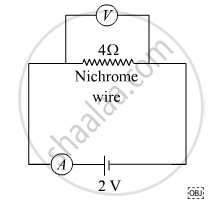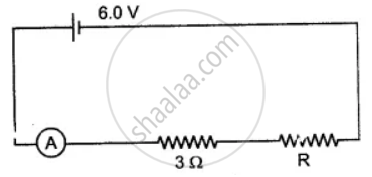Advertisements
Advertisements
Question
A V-I graph for a nichrome wire is given below. What do you infer from this graph? Draw a labelled circuit diagram to obtain such a graph.

Solution

The graph between V & I is a straight line.
So we can conclude that Current flowing through the wire is directly proportional to the potential difference V across it.
The resistance of the wire can be calculated as
`"R" = "v"/1 = 0.4/0.1 = 4Ω`
We can also conclude that nichrome wire has a constant value of the resistance as 4 Ω4 Ω.
nichrome wire follows ohm's law thus it behaves as an ohmic conductor.
The circuit diagram corresponding to the above graph is as shown below.

APPEARS IN
RELATED QUESTIONS
How much energy is transferred by a 12 V Power supply to each coulomb of charge which it moves around a circuit?
A potential difference of 20 volts is applied across the ends of a resistance of 5 ohms. What current will flow in the resistance?
Explain the statement ‘the potential difference between two points is 1 volt’.
Water in the waterfall flows from a higher level to the lower level because of ____________.
The figure shows a circuit. When the circuit is switched on, the ammeter reads 0.5 A.

(i) Calculate the value of the unknown resistor R.
(ii) Calculate the charge passing through the 3 Ω resistor in 120 s.
(iii) Calculate the power dissipated in the 3 Ω resistor.
Define electric potential and potential difference.
How will you conclude that the same potential difference (voltage) exists across three resistors connected in a parallel arrangement to a battery?
Define Electric potential.
______ is work done per unit charge.
Study the following circuit and find:

- Effective resistance of the circuit
- Current drawn from the battery
- Potential difference across the 5 omega resistor
